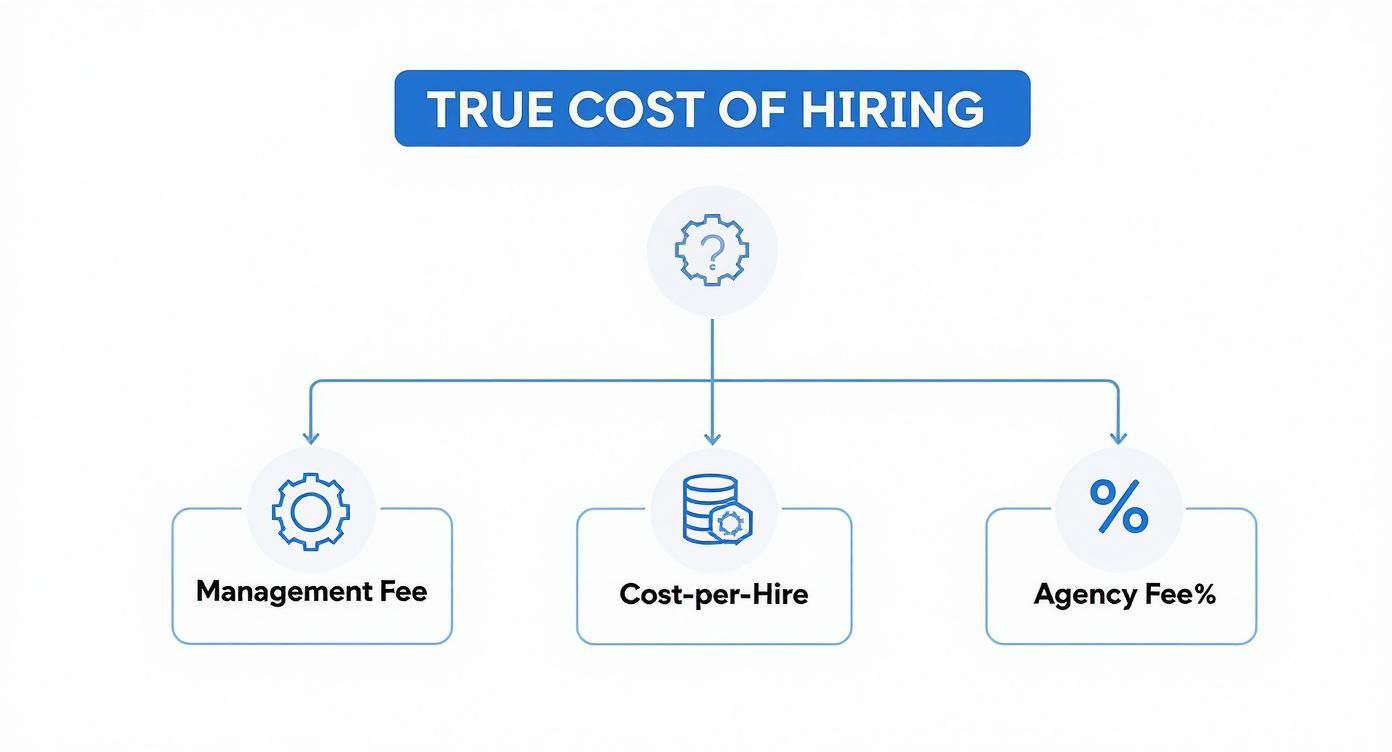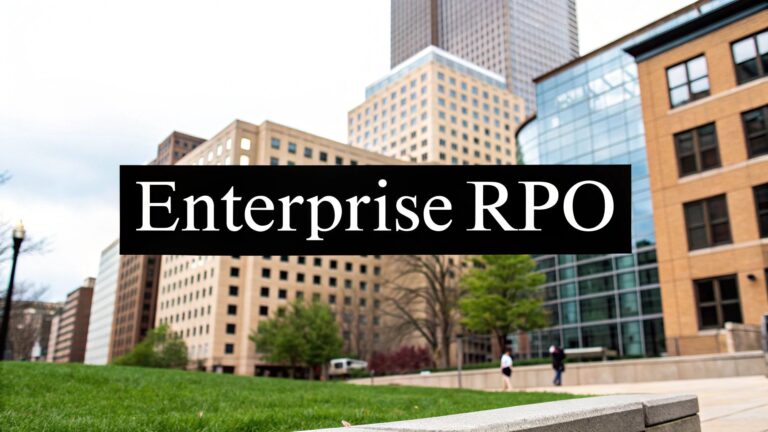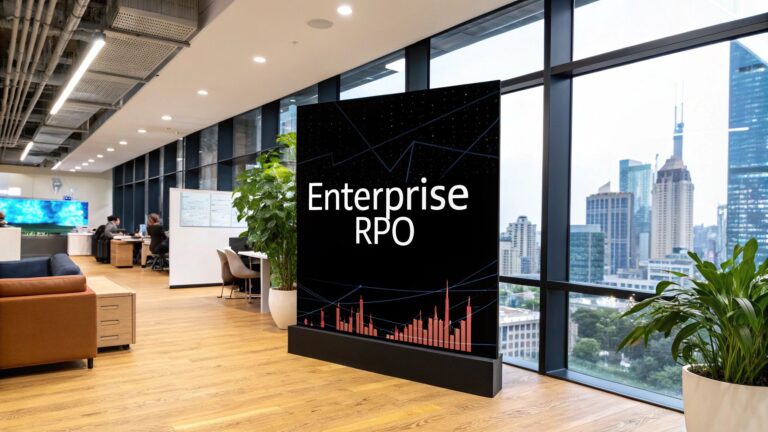For any Chief Human Resources Officer, the choice between RPO vs. a staffing agency isn’t just a procurement decision—it’s a strategic fork in the road that defines your entire approach to talent acquisition. The difference is simple but profound: a Recruitment Process Outsourcing (RPO) provider is an embedded strategic partner that manages your entire recruitment ecosystem. A staffing agency, on the other hand, is a transactional vendor, focused on one thing: filling specific, immediate vacancies quickly.
Choosing Your Strategic Hiring Partner

Navigating today’s talent landscape requires more than just filling seats. It demands a forward-thinking strategy that aligns directly with your long-term business goals. The RPO versus staffing agency debate gets right to the heart of this, forcing you to decide if you need a complete overhaul of your talent engine or just a rapid-fire solution for immediate headcount needs.
This guide goes beyond the textbook definitions. We’ll get into the real-world operational, financial, and strategic implications of each model, giving you a clear framework to make the right call. The ultimate goal is to ensure your choice directly fuels your company’s growth, strengthens its culture, and reflects its core talent philosophy.
Understanding the Core Models
To make a smart decision, you have to appreciate the distinct philosophies behind each service. One is about building and owning the process for the long haul; the other is about tapping into a ready-made network for a specific outcome.
- RPO as an Extension of Your Team: An RPO provider doesn’t just work for you; they become a part of your organisation. They live and breathe your employer brand, operate within your systems (or bring in better ones), and function as a seamless extension of your HR department. This model is all about process improvement, data-driven insights, and building sustainable talent pipelines for the future.
- Staffing Agency as a Marketplace: Think of a staffing agency as a highly specialised marketplace. They maintain a vast, pre-vetted database of candidates and are experts at matching skills on a CV to a job description—fast. Their relationship is almost always transactional, ending the moment a position is successfully filled.
A simple way to look at it: an RPO partner helps you build a better fishing rod and teaches your team how to fish more effectively. A staffing agency just sells you fish when you’re hungry.
A Quick Comparison
Grasping these fundamental differences is your first step. For a closer look at the benefits and specific services, you can explore more about what is Recruitment Process Outsourcing and see how it might integrate into your wider HR strategy. The table below gives a high-level summary of the key distinctions.
| Feature | Recruitment Process Outsourcing (RPO) | Staffing Agency |
|---|---|---|
| Relationship | Strategic, long-term partnership | Transactional, role-based |
| Scope of Work | End-to-end recruitment process management | Sourcing and placing candidates for specific roles |
| Accountability | Shared responsibility for KPIs and business outcomes | Responsibility for filling a vacancy |
| Focus | Process improvement, employer branding, talent quality | Speed-to-hire, filling immediate needs |
| Cost Model | Management fee, cost-per-hire, or hybrid models | Percentage of the placed candidate’s annual salary |
Comparing the RPO and Staffing Agency Models

To really get to the heart of the RPO vs. staffing agency debate, you have to look past the service lists and understand their core philosophies. One is a proactive, strategic partner looking to transform your talent function from the inside. The other is a reactive, transactional service built to solve an immediate problem as quickly as possible.
An RPO provider essentially becomes an extension of your team. They immerse themselves in your company culture, take on your employer brand as their own, and manage the entire recruitment journey. This is a deep, long-term engagement.
In contrast, a staffing agency acts as an external supplier. Their power lies in a vast, pre-screened candidate database and the ability to rapidly match skills to a specific job description. Their work is targeted, and their involvement typically ends once the role is filled.
The RPO Partnership Model
The RPO model is all about long-term strategic alignment. An RPO partner doesn’t just fill your open positions; they design and run a complete talent acquisition strategy that plugs directly into your wider business goals.
- Process Ownership: From sourcing and screening right through to offer management and onboarding, RPO providers take full ownership. They bring their expertise to the table to refine and improve every single step.
- Technology Integration: They often bring in or manage your applicant tracking systems (ATS) and other recruitment tech, making sure your hiring is efficient and backed by solid data.
- Brand Ambassadorship: Every candidate touchpoint, from the first outreach to the final offer, happens under your company’s banner. This actively strengthens your employer value proposition in the talent market.
This integrated approach is quickly gaining ground. The recruitment process outsourcing market in India, for example, is seeing huge growth as companies look for more strategic talent solutions. Businesses using RPO have reported cost savings of up to 30% simply by streamlining their processes.
Globally, the RPO market hit USD 7.33 billion in 2022 and is expected to grow at a CAGR of 16.1% through 2030, with India becoming a major player. You can find out more about the evolving RPO landscape in India and what’s driving this shift.
The Staffing Agency Transactional Model
Staffing agencies are the specialists you call for speed and precision on specific hires. Their model is built for a rapid response, drawing from an existing candidate pool to fill vacancies with minimal delay.
A key differentiator is accountability. An RPO is accountable for the overall performance of your recruitment function—metrics like quality-of-hire and time-to-fill. A staffing agency is primarily accountable for one thing: presenting qualified candidates for a specific role.
The agency’s process is typically straightforward and laser-focused:
- They receive a job requisition from you.
- They search their internal database and external networks for matching candidates.
- They screen and send over a shortlist of qualified people.
- They collect their fee once a candidate is successfully placed.
This plug-and-play approach is incredibly effective for filling temporary roles, covering parental leave, or bringing in niche skills for a short-term project. What it doesn’t do is influence your long-term talent strategy or improve your internal processes. The choice between an RPO vs staffing agency really boils down to whether you need a partner to build your hiring machine or a vendor to simply fill a seat.
Analysing Key Performance and Operational Metrics
When you’re comparing an RPO partner to a staffing agency, you have to look past the service descriptions and dig into the real performance numbers. For a Chief Human Resources Officer, the final call always comes down to the operational metrics that directly shape business results. The right choice depends entirely on what you’re prioritising: long-term talent quality, immediate speed, operational scale, or managing risk.
Each model is wired to deliver on a different set of Key Performance Indicators (KPIs). An RPO is built to improve the whole system over time—think better quality of hire and more efficient processes. A staffing agency, on the other hand, is designed to crush transactional metrics like speed-to-hire for one-off roles.
Quality of Hire: The Strategic Differentiator
Quality of hire is probably the single most important long-term talent metric, and it’s where the two models really show their differences. It’s all about the value a new employee brings to the business, usually measured through performance reviews, productivity levels, and how long they stay after that crucial first year.
An RPO partner sees this as a long game. Their whole process is geared towards finding people who not only have the right skills but also genuinely fit your company’s culture, values, and vision for the future. They take the time to really get to know your teams and figure out what makes someone truly successful in your unique environment.
A staffing agency, by nature, is much more focused on matching skills and experience. Their main job is to quickly get you a shortlist of candidates who can do the work from day one. These candidates are often fantastic at what they do, but the deeper dive into cultural fit and long-term potential naturally takes a backseat to filling the immediate gap.
The core distinction is one of intent. An RPO is accountable for a new hire’s long-term success and retention, directly impacting the business’s bottom line. A staffing agency is accountable for filling the role with a qualified individual, with their involvement often ending after the placement is complete.
Speed to Hire: A Tale of Two Timelines
Speed-to-hire, often called time-to-fill, simply measures how long it takes from opening a job to a candidate signing on the dotted line. While both models want to be efficient, their methods lead to very different timelines and expectations.
Staffing agencies are built for pure speed. They have a deep bench of pre-vetted active and passive candidates ready to go. When a new role comes up, they can often have a solid shortlist on your desk within days. This makes them the perfect fix for urgent needs, backfills, or temporary positions where an empty seat is costing you money.
RPO providers play a more structured, process-driven game. The initial setup takes time—there’s discovery, process mapping, and tech integration to sort out—which means the first few hires might feel a bit slower. But once that foundation is laid, their proactive talent pipelining and fine-tuned processes can dramatically cut down hiring times for all future roles, creating efficiency that lasts. They might build talent communities for roles you hire for often, engaging great people long before a vacancy even opens up. For a closer look at this in action, check out the real-world example of how OYO Rooms boosted its hiring metrics through a strategic partnership.
Scalability and Compliance: Navigating Growth and Risk
For any growing company, the ability to ramp hiring up or down while staying compliant is absolutely critical.
This is where RPO providers really shine. The flexibility RPO offers has made it a go-to for Indian organisations facing unpredictable hiring needs. An RPO partner can dynamically add or remove recruitment resources to handle massive projects, expansions into new markets, or sudden growth spurts without forcing you to add permanent HR staff. It’s an adaptable model built for business expansion.
Staffing agencies provide a different kind of flexibility. They’re brilliant at scaling up to fill multiple, similar roles fast—like hiring a temporary customer service team for the festive season. However, trying to scale across many different departments or for a long-term, high-volume push can get clunky and less cost-effective than an RPO.
When it comes to compliance and risk, an RPO partnership means you have a co-pilot. They become a custodian of your recruitment process, helping to ensure everything is aligned with labour laws and diversity standards. A staffing agency’s liability is much more limited; it’s focused on the placement itself, leaving the broader compliance headache with your in-house team.
The table below breaks down these crucial differences based on the metrics that matter most.
RPO vs Staffing Agency Operational Metrics at a Glance
For a CHRO, choosing between these models means understanding how each one performs against core operational goals. This table offers a side-by-side view to help clarify which partner aligns best with your strategic objectives.
| Metric | Recruitment Process Outsourcing (RPO) | Staffing Agency |
|---|---|---|
| Quality of Hire | Core focus. Process is designed for long-term cultural and performance fit. | Secondary focus. The priority is matching immediate skill requirements. |
| Speed-to-Hire | Slower initial setup, but becomes faster and more predictable over time with proactive pipelining. | Extremely fast for individual roles by leveraging existing, pre-vetted candidate pools. |
| Scalability | High. Built to handle large, sustained, or fluctuating hiring volumes across the entire organisation. | Moderate. Excellent for ad-hoc or project-based needs; less efficient for enterprise-wide scaling. |
| Risk & Compliance | Shared accountability. The RPO partner helps manage compliance across the entire recruitment lifecycle. | Limited liability. Compliance responsibility for the overall process largely remains with the client. |
Ultimately, whether you need the rapid, targeted response of a staffing agency or the strategic, integrated approach of an RPO depends entirely on the specific performance outcomes you’re trying to achieve for the business.
Looking Beyond the Price Tag: The True Cost of Hiring
When you’re deciding between an RPO and a staffing agency, just looking at their fee percentages is a rookie mistake. A savvy CHRO knows the real story is in the Total Cost of Ownership (TCO), which covers both the obvious fees and all the hidden expenses that creep up later. Getting this right means you can budget accurately and avoid nasty surprises down the line.
For RPO partnerships, the costs usually break down into two main parts: a fixed management fee and a cost-per-hire. The management fee is for the ongoing service, the tech they bring, and the constant process tweaks. The cost-per-hire bit links what you spend directly to how many people you actually hire, which keeps everyone honest.
But here’s the thing—this structure often leads to significant savings in the long run. By focusing on quality hires, RPOs help slash turnover rates, which means you’re not constantly paying to re-fill the same roles. They also cut down vacancy periods, so you lose less productivity. And by taking on the admin load, they free up your internal HR team to focus on bigger-picture strategy instead of paperwork.
How RPO Pricing Actually Works
- Fixed Management Fee: This covers the big stuff like end-to-end recruitment management, running your Applicant Tracking System (ATS), and regular check-ins to make sure everything is running smoothly.
- Cost-per-Hire Fee: This is where performance comes in. You might see volume-based discounts if you’re hiring a lot, or even penalties for the RPO if offers fall through or new hires leave too quickly.
“An RPO model turns the chaotic, unpredictable costs of hiring into a stable, predictable investment.” – a sentiment echoed by many forward-thinking talent acquisition directors.
This approach makes it much easier to forecast your annual budget. Your costs stay pretty stable unless your hiring volume goes completely off the charts.
Now, let’s switch gears to staffing agencies. Their TCO is almost always built around a percentage-of-salary fee, which can be anywhere from 15% to 30% of a new hire’s first-year salary. For senior or highly specialised roles, this fee can skyrocket, making your budget feel like a moving target.
Plus, agencies don’t typically share the pain of a long vacancy. Every day a critical role sits empty, it’s hitting your operations, but there’s no financial credit or discount coming your way. While they handle the screening and initial onboarding, the heavy lifting of employer branding and process improvements still falls on your team, adding hidden management costs you have to account for.
A Head-to-Head Cost Comparison
| Cost Element | RPO Model | Staffing Agency |
|---|---|---|
| Initial Setup | One-time integration fee | Minimal or none |
| Technology Investment | Included in management fee | Usually on you to procure |
| Fee Structure | Fixed fee + cost-per-hire | Percentage of salary |
| Turnover Mitigation | Proactive retention strategies | Very limited post-placement support |
| Vacancy Reduction | Builds talent pipelines to cut delays | Fills roles reactively, but no credits for lag |
| Administrative Overhead | RPO handles most process work | Your team manages branding and compliance |
| Total Predictability | High predictability | Variable, depends on role seniority |
This table gives you a clear snapshot of how each model distributes costs. It’s a great starting point for projecting your annual spend based on different hiring scenarios you might be facing.
How to Calculate Your Own TCO
Want to get a real estimate? Follow these steps:
- Figure out your projected headcount growth for the next year.
- Estimate the mix of junior, mid-level, and senior roles you’ll need, along with their salary bands.
- Plug in the RPO’s proposed cost-per-hire and fixed fees.
- Now, compare that to what you’d pay a staffing agency based on their percentage fees for each salary level.
- Factor in the cost of lost productivity for each day a role is vacant (the industry average is around 30 days).
- Add in the value of the internal admin time you’d save with an RPO.
- Don’t forget to adjust for a potential drop in turnover—good RPOs can cut it by 20% or more.
This isn’t just about comparing fees; it’s a full financial model that reflects the long-term impact on your business.
For example, a high-growth tech company planning to bring on 200 new people might discover an RPO saves them 15% a year, mostly by filling roles faster and reducing the number of people who leave. On the flip side, a manufacturing plant with only a handful of specialised hires each year might find a staffing agency’s pay-as-you-go model more economical.
It boils down to this: if your hiring is predictable and high-volume, the stability of an RPO model is incredibly valuable. If your needs are sporadic and specialised, paying a one-off placement fee to an agency might make more sense.
Key insight: When you’re calculating the true cost of hiring, risk mitigation and budget predictability are often far more important than the headline fee percentage.
By laying your hiring forecasts over these cost models, you get a crystal-clear picture of which partner aligns with your financial strategy and your talent goals. It’s about making an informed decision that balances what you pay today with the value you get tomorrow. Running a few scenarios over a couple of years will show you where the budget peaks and troughs are, helping you invest in hiring much more strategically.
When to Choose RPO vs a Staffing Agency
Deciding between an RPO partner and a staffing agency really boils down to one simple, but critical, question: what problem are you actually trying to solve?
The right choice has nothing to do with which model is “better” and everything to do with your specific business context. Are you putting out a fire caused by an immediate headcount crisis, or are you building a sustainable talent acquisition engine for the long haul? This framework will help you map your real-world needs to the right solution.
At its heart, the “RPO vs staffing agency” dilemma is about strategic intent versus tactical execution. One model helps you build a system; the other delivers a resource. Your choice will have a direct ripple effect on your budget, your employer brand, and your ability to scale.
Ideal Scenarios for a Staffing Agency
A staffing agency is your go-to for clearly defined, short-term, or highly specialised hiring needs. Their superpower is speed and immediate access to a warm bench of candidates for specific roles.
You should be calling a staffing agency when you’re facing situations like these:
- Immediate or Unpredictable Vacancies: A key team member just resigned unexpectedly, or a new project just landed that needs someone, stat. Agencies are built to deliver qualified candidates in a matter of days.
- Short-Term or Contractual Needs: Your business needs temporary cover for seasonal peaks, parental leave, or specific projects with a clear finish line.
- Highly Niche Skill Sets: You need to find one person with a very specific, hard-to-find skill, and your internal team simply doesn’t have the network to track them down efficiently.
- Low-Volume, Infrequent Hiring: Your company only hires a handful of people each year. In this case, a full-time in-house recruiter or a comprehensive RPO partnership would be overkill.
For these scenarios, the transactional, pay-per-placement model of an agency gives you maximum efficiency without any long-term strings attached.
This decision tree infographic is a great way to visualise how different cost structures and hiring volumes should guide your choice.

As the visual shows, the predictable, fixed-fee nature of RPO is a natural fit for strategic, high-volume needs. In contrast, the percentage-based agency fee is much better suited for those immediate, one-off placements.
When an RPO Partner Is the Superior Choice
Recruitment Process Outsourcing is a strategic investment, plain and simple. It’s designed for long-term impact. An RPO is the right move when your goal isn’t just about filling seats but about fundamentally elevating your entire talent acquisition process.
Think about bringing on an RPO partner in the following scenarios:
- Sustained, High-Volume Hiring: Your organisation is in a serious growth phase, planning a major expansion, or consistently hiring dozens (or hundreds) of people year after year. An RPO provides the scalable infrastructure to handle that volume without breaking a sweat.
- A Need for Process and Technology Improvement: Your current recruitment processes feel a bit patched together—they’re inconsistent, inefficient, or lack the technology (like a modern ATS) to get you where you need to go. RPOs bring best-in-class processes and tech stacks to the table.
- Building a Proactive Talent Pipeline: You want to get off the back foot. Instead of scrambling every time a role opens up, you want to proactively build talent communities for critical positions, slash your future time-to-fill, and ensure a steady pipeline of qualified candidates.
- Strengthening Employer Brand and Candidate Experience: You’ve realised your candidate experience is letting you down and want a partner who will act as a true ambassador for your brand. They ensure every single applicant interaction is positive and professional. You can dig deeper into the key advantages of having an RPO partner to see how significant this impact can be.
An RPO isn’t a quick fix; it’s a foundational change. It’s about building a robust, efficient, and scalable talent engine that becomes a genuine competitive advantage for your business over time.
As a leader, ask your team this critical question: “Are we trying to solve an immediate headcount problem for this quarter, or are we building a long-term talent engine that will fuel our growth for the next five years?” Your answer will point you directly to the right solution.
Ready to build a strategic talent engine that drives business growth? At Taggd, we deliver customised RPO solutions that transform your recruitment function into a competitive advantage.







